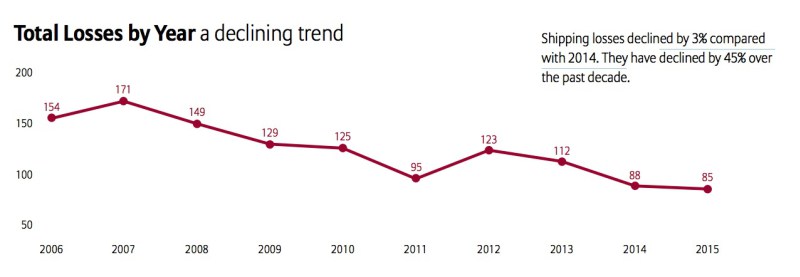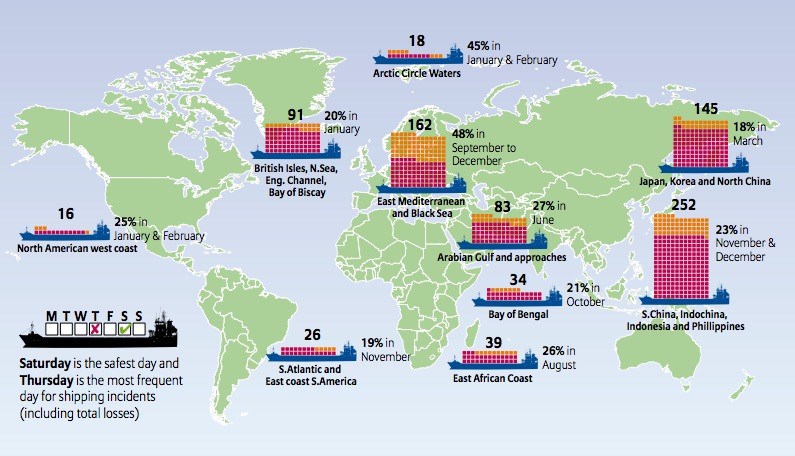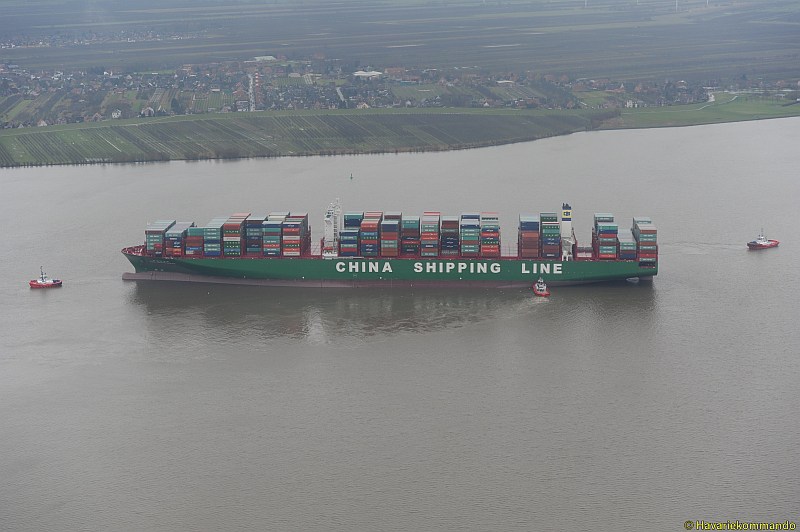Despite what you may think from reading the news, the number of total losses and casualties in shipping each continued the decade-long downward trend in 2015, with 85 reported total loss incidents worldwide, according to Allianz Global’s (AGCS) fourth annual Safety and Shipping Review 2016.
Although the number of losses remained stable year-on-year, declining just 3% compared to 2014 losses, 2015 ranked as the safest year in shipping for a decade, according to Allianz’s review, which analyzes reported losses of over 100 gross tons. Losses have declined by 45% since over the last decade, driven by an increased safety environment and self-regulation. However, Allianz’s tracking shows that disparities by region and vessel-type remain.

More than a quarter of all losses in 2015 occurred in the South China, Indochina, Indonesia and Philippines region (22 ships), which according Allianz is an an increase year-over-year, unlike other major regions.
Cargo and fishing vessels accounted for over 60% of ships lost globally, with cargo losses up for the first time in three years, Allianz reports. The most common cause of total losses is foundering (sinking), accounting for almost 75% of losses, up 25%, and often driven by bad weather.

Accounting for all casualties including total losses, there were 2,687 reported shipping incidents globally during 2015, down 4% from 2014.
An interesting figure Allianz tracked was that activity is spread across all days of the week, although Thursday sees the most incidents and Saturday the fewest. The East Mediterranean and Black Sea (484) remains the top incident hotspot. Three vessels share the accolade of being the most incident-prone: a roll-on/roll-off ship in the Great Lakes region, a hydrofoil in the East Mediterranean & Black Sea and a ferry in the British Isles, with 19 incidents over the past decade, according to Allianz.
Economic pressures challenge safety advances
Allianz notes that while the long-term downward trend in shipping losses is encouraging, the continuing weak economic and market conditions, depressed commodity prices and an excess of ships are adding pressure to reduce costs, raising some safety concerns. Allianz has seen an increase in frequency losses over the past year which can likely be attributed to some extent to this environment.
“The economic downturn – and its impact on the shipping sector – is likely to have a negative impact on safety,” says Captain Rahul Khanna, Global Head of Marine Risk Consulting, AGCS. “Many sectors, such as general cargo, bulk and offshore, are already challenged and any drop in safety standards will be a serious case for concern.”
It is critical that economic pressures do not allow a “put it off until later” safety mentality to develop, AGCS experts warn. Some shipowners are already stretching maintenance to longest possible intervals while others are laying-up vessels. “Reactivation of these vessels to a market that has moved on technologically may result in a painful exercise. There is a need for standardized lay-up procedures,” says Captain Jarek Klimczak, Senior Marine Risk Consultant, AGCS.
As well as impacting investment in maintenance, cost pressures can impair crewing conditions, passenger ship safety, and salvage and rescue. AGCS has seen an increase in fatigue-related insurance claims over the past decade. With crew numbers already often at their lowest possible level, and a future staffing shortage anticipated, longer shift patterns could exacerbate this issue. Meanwhile, training remains below par in some areas, such as electronic navigation, which should not be seen as panacea but as a complementary tool.
Although significant progress has been made in passenger ship safety, concerns remain, particularly around non-international voyages. Some parts of Asian domestic trade are years behind international standards, as evidenced by a number of recent ferry losses in South East Asian waters. Profit pressures mean scheduling maintenance can be challenging.
“Mega ships” and superstorm ship sinkings

The appetite for ever-larger container ships has seen cargo-carrying capacity of the largest vessels increase by 70% over 10 years to 19,000+ containers. Two “mega ships”, the CSCL Indian Ocean and APL Vanda were grounded in February 2016, raising questions about a more serious incident. There are concerns commercial pressures in the salvage business have reduced easy access to the salvors required for recovery work on this scale. The industry may need to prepare for a $1bn+ total loss scenario.
The report also notes that exceptional weather events are becoming more commonplace, bringing additional risks and disruption to supply chains. This year, the effect of a “super” El Niño is expected to lead to more extreme weather conditions. Meanwhile, bad weather was a factor in three of the five largest vessels lost last year, including the El Faro, one of the worst US commercial maritime disasters in decades. “The fact that superstorms are causing ships to sink is concerning,” says Sven Gerhard, Global Product Leader Hull & Marine Liabilities, AGCS. “We are seeing more and heavier natural catastrophe events. Weather routing will continue to be a critical component to the safe navigation of vessels.”
Cyber risk evolves, as piracy threat grows
The shipping industry’s reliance on interconnected technology also poses risks, according to Allianz. Cyber risk exposure is growing beyond data loss. There have already been a number of notable cyber incidents and technological advances including the “Internet of Things” (IoT) and electronic navigation means the industry may only have a few years to prepare for the risk of a vessel loss. “Pirates are already abusing holes in cyber security to target the theft of specific cargoes,” says Captain Andrew Kinsey, Senior Marine Risk Consultant, AGCS. “The cyber impact cannot be overstated. The simple fact is you can’t hack a sextant.”
For the first time in five years piracy attacks failed to decline in 2015, Allianz reports. South East Asian attacks rose, accounting for 60% of all incidents, while attacks in Vietnam surged year-on-year.
Other risks identified in the report include:
Lower emissions safety threat: There have been unexpected safety implications from the shipping industry’s drive to reduce emissions, resulting in power issues related to rising use of ultra-low sulfur fuel. AGCS has seen an increase in machinery claims related to fuel.
Arctic casualties rising: There were over 70 reported shipping incidents in Arctic Circle waters during 2015 – up almost 30% year-on-year, the highest in a decade. The incoming Polar Code is welcomed, but safety questions remain about best practices and clean-up.
Full Report: Safety and Shipping Review 2016 (opens in pdf)